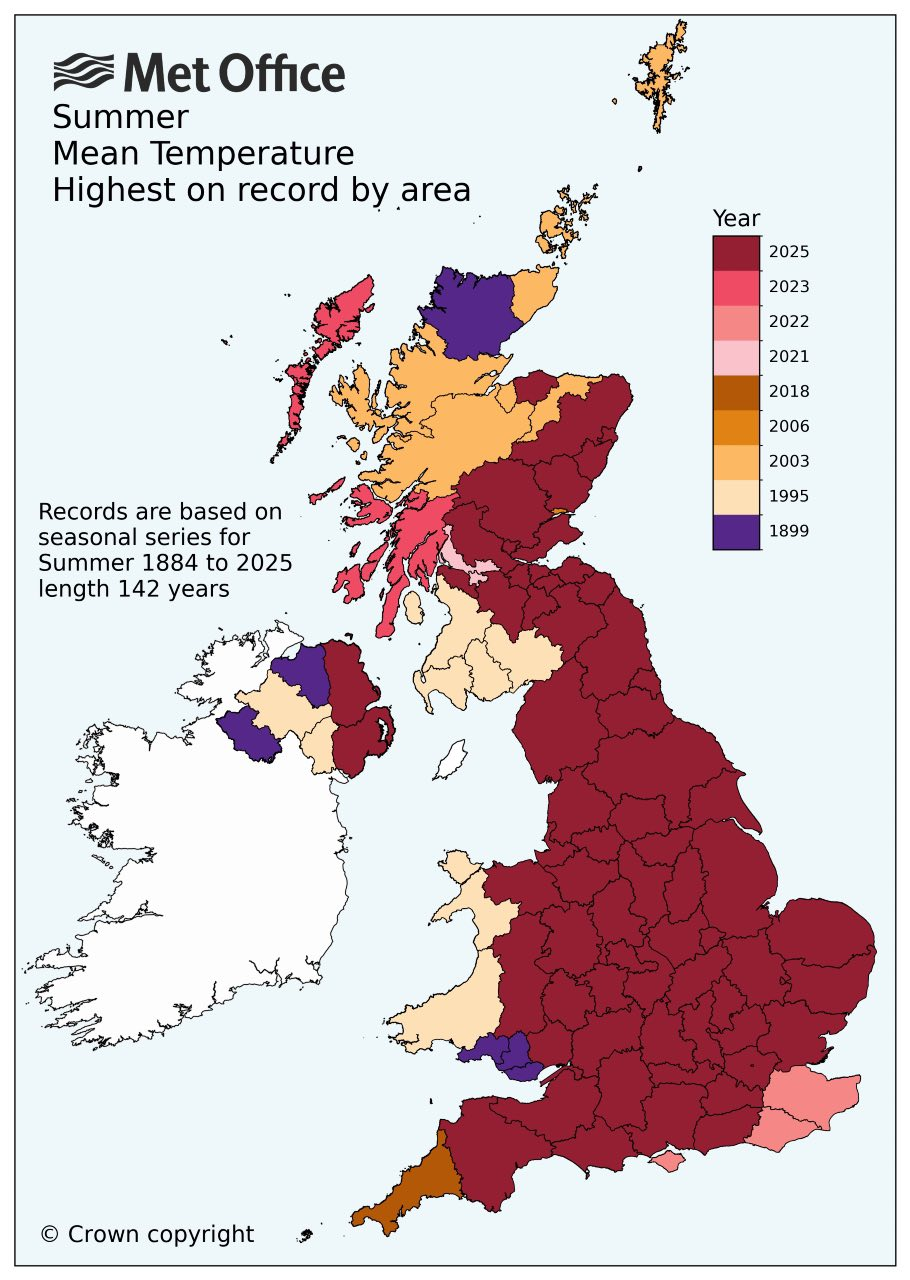UK Counties Summer Mean Highest Temperature Record Map


David Chen
Data Visualization Specialist
David Chen is an expert in transforming complex geographic datasets into compelling visual narratives. He combines his background in computer science ...
Geographic Analysis
What This Map Shows
The map titled "Map showing the years of each UK county's summer mean highest temperature record since 1899" provides a fascinating glimpse into the weather patterns across the United Kingdom over more than a century. It highlights the year when each county recorded its highest average summer temperature, illustrating how climate has varied across different regions of the UK. This kind of visualization allows us to identify trends in temperature and can even hint at broader climate changes affecting the region.
Deep Dive into Temperature Trends in the UK
When we dive into the subject of temperature records, particularly summer mean highest temperatures, we uncover a complex interplay of geographical, climatic, and environmental factors. Since 1899, the UK has experienced significant fluctuations in temperature, influenced by both natural variability and anthropogenic climate change. The average temperature in the UK has risen by approximately 1°C since the mid-20th century, with summers becoming increasingly warmer.
Interestingly, specific years stand out on this map. For instance, 2019 was notably warm across many counties, with numerous places recording their highest summer mean temperatures. This event was part of a broader trend that has seen more frequent heatwaves in the UK over the past few decades. The increasing frequency of these heatwaves can be attributed to climate change, which is intensifying weather patterns globally.
Different regions of the UK experience varying temperature patterns due to geographical factors. For example, coastal areas typically benefit from maritime influences that moderate temperature extremes, while inland regions may experience more pronounced heat during summer months. This phenomenon explains why counties like Cornwall, which is located on the coast, might have different temperature records compared to counties like Kent, which is more inland.
Moreover, elevation plays a significant role in temperature variations. Counties that are part of the hilly or mountainous terrains, such as those in Wales or Scotland, may not experience the same high summer temperatures as lower-lying areas. The topography affects how heat is distributed and retained in the environment, leading to variations in recorded temperatures.
Regional Analysis
Examining the map reveals intriguing regional differences in temperature records. In the Southeast, counties such as Surrey and Kent often show earlier records of high summer temperatures, reflecting both their geographical position and urban heat effects. Urban areas tend to be warmer due to the heat generated by buildings, vehicles, and industrial activities, a phenomenon known as the urban heat island effect.
Conversely, regions such as Scotland and Northern Ireland show a later peak in their temperature records, largely due to their cooler maritime climates and higher altitudes. For example, counties in Scotland, like Aberdeenshire, recorded their highest mean summer temperatures much later than their counterparts in the south. This divergence highlights the varying impacts of climate change across the UK, as some areas warm more quickly than others.
Interestingly, the West Midlands and the North West, which include significant urban centers, show some of the most dramatic increases in temperature records. These changes can be linked to both urbanization and climate change, making it essential to understand how human activities are reshaping the climate landscape.
Significance and Impact
Understanding summer mean highest temperature records is crucial for several reasons. Firstly, these temperature trends are directly linked to agricultural practices, water resources, and biodiversity. Farmers need to adapt their practices based on temperature predictions to ensure crop yields, while wildlife must also adjust to changing habitats and food availability.
Moreover, the health implications of rising temperatures cannot be overlooked. Increased heat can lead to heat-related illnesses, particularly among vulnerable populations such as the elderly. Communities must plan for these changes, investing in public health initiatives and infrastructure to cope with hotter summers.
Looking forward, climate models suggest that the UK will continue to experience warmer summers, with more frequent and intense heatwaves. This necessitates proactive measures to mitigate the effects of climate change and adapt to the new normal we are facing. As we analyze the data presented in this map, it becomes clear that understanding temperature records is not merely an academic exercise; it has real-world implications for society as a whole. By recognizing trends, we can better prepare for the future and work towards a sustainable environment.
Visualization Details
- Published
- September 3, 2025
- Views
- 92
Comments
Loading comments...